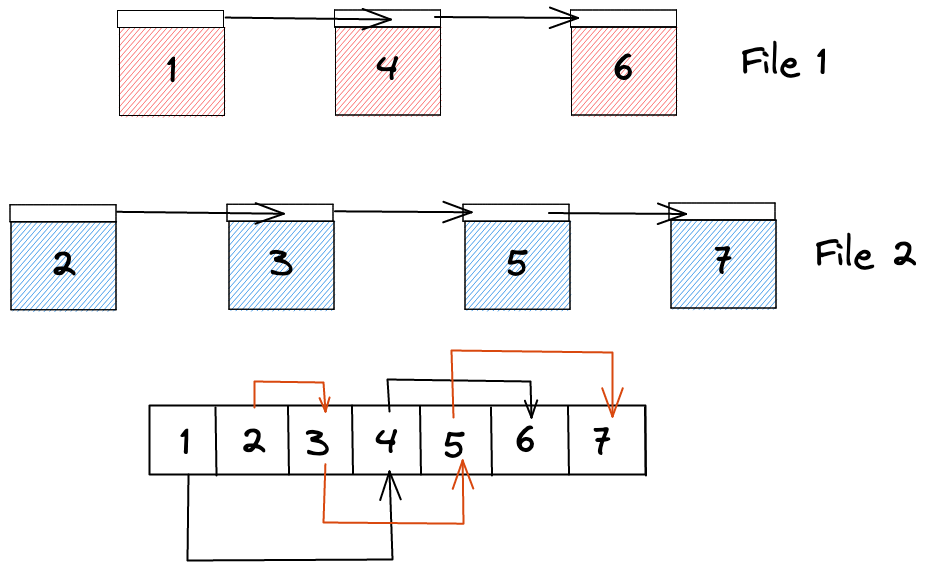Leaning Objectives
At the end of this lecture, you should be able to:
-
Define the services that a filesystem offers and how they can be organize.
-
List different filesystem organization strategies.
-
Identify advantages and disadvantages of each organization strategy.
Topics
-
Filesystem organization.
-
File Allocation Table (FAT).
-
I-nodes.
Notes
Introduction
- Files are an essential part of the services provided by the operating system
- In Linux, everything is a file
- Memory is good, but we need to go beyond memory into the concept of files that
represent blocks or streams of data
- Most importantly, all processes need to be able to store files persistently on the machine
- i.e., they must be able to access them later without rewriting everything
Requirements
- A storage system must meet the following requirements:
- It must be able to host a very large amount of data
- The data must persist even after the process that created it is destroyed
- Multiple processes must be able to access the information simultaneously (with some constraints)
-
Disks are the natural storage systems that provide us with the above requirements
- It is the job of the operating system to act as a glue and manage the disk and access to the disk from users and processes
Overview

Some Definitions
- Question: How would define a file?
- A file is a logical unit of information, created by a process
- Let’s look at how the OS organizes files
- A disk can be divided into partitions
- The first partition is called the Master Boot Record (MBR)
- It is used to boot the computer initially
- At the end of the MBR is the partition table
- The first partition is called the Master Boot Record (MBR)
The Boot Cycle


The Crux
-
The most important question that we would like to answer is how do we allocate disk blocks to files?
-
We will explore four techniques:
- Contiguous allocation.
- Linked list allocation.
- File Allocation Table (FAT).
- Inodes or index nodes.
Contiguous Allocation
- In contiguous allocation, we store each file a contiguous stream of disk block
- e.g., a 50KB file would require 50 contiguous 1 KB blocks to be stored

Advantages
- Can you think of any advantages to this approach?
- Very simple to implement
- We only need to know the starting block to find any block in the file
- If I know the first, then the 50th block is simply 50 block forwards
Disadvantages
- What problems can you foresee with this approach?
- Fragmentation:
- Consider that we delete files 2 and 4 from the diagram above
- We want to allocate now file 5 that needs 3 blocks of data
- What happens then?
- We have the room for file 5, but they are not contiguous
- Disk is now a bunch of files and holes
- Defragmentation is expensive, so we must try to avoid it as much as we can
- Need to know the size of the entire file before we can store, cannot have
dynamic file allocation
- Imagine a word processor this way, it would suck!
- Fragmentation:
Linked list
- What dynamic data structure replaces an array?
- Yes a linked list
- In linked list allocation, each block contains a pointer to the next block in the file

Advantages
-
No external fragmentation, we can use any open spot in the disk
-
We only need to know the first block in a file to have access to the full blocks in the file
Disadvantages
- Accessing a file randomly is very slow
- Imagine we want to access blocks 5 and 150 from a certain file
- We’d have to traverse the entire linked list only to get two blocks
- Each block will have to store some metadata and a pointer to the next block
- The block size is no longer a power of two
- Freak out!!!!!
File allocation table (FAT)
- Can we do any better than storing the pointers to the next block inside each block?
- Yes, put the logical linked list in memory, and the actual blocks on disk
- Traversing the file is now much faster since the linked list is now in memory
- Only fetch the blocks that you need after traversing the table

Problems
- The FAT table must be in memory at all time.
- We must keep the information about each file even if we do not currently need
it.
- size limit on the size of the FAT table as well as the size of the physical disk.
Index nodes (inodes)
- Let’s make this better
- Now, we store for each file an index node (or
inode)- It is a data structure that contains file attributes, author information, access rights, etc.
- Most importantly, it contains the addresses of the file’s blocks
inodesare stored on disk, unless they are actually needed- So keep information in memory only about the active files
-
The main advantage is that the
inodetable is much smaller than the FAT - The size of an
inodeblock is proportional to the file size and not to the disk size